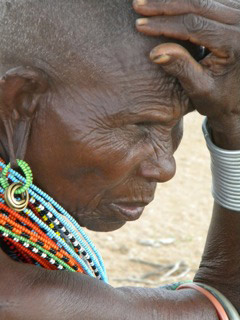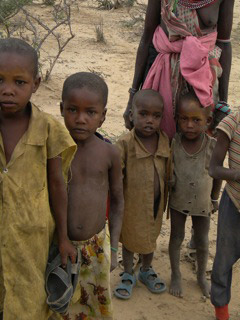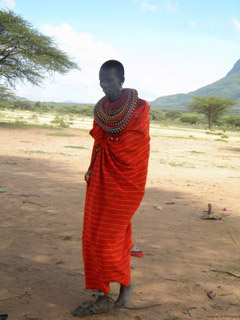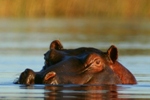Africa Wildlife Foundation (AWF), the conservation nonprofit based in Washington, DC, is facing a lawsuit by Kenya’s Samburu tribe over alleged unlawful evictions. The hearing, originally scheduled for January 23, has now been postponed to later this month.
The dispute is over an area of land in Laikipia District in Kenya, one of Africa’s most wildlife rich areas. Until recently, it was also the homeland of some 2,000 semi nomadic members of the Samburu tribe. At least according to the Samburu.
In a statement on their website, AWF says that the plaintiffs never actually lived on the land in question. They claim that the Samburu testified that they lived in an area ‘neighboring’ to the land. But Travis LeSalle, an Associated Attorney at the Center for International Human Rights Law and Advocacy, who has been to the region, says this couldn’t be further from the truth: “The Pois and Sukoroi communities….occupied the suitland as a permanent settlement since the 1980’s.” He also noted that the area had been part of the Samburu’s ancestral land since the 15th century, though it did not become their permanent residence until the early 80s. This is typical of indigenous communities who relocate frequently within a large area.
 A displaced Samburu elder from Kenya’s Laikipia district. The Samburu now live exposed to the elements in makeshift huts in the bush after police evictions forced them from their homes. Photo © Samburu Watch/Survival International. |
This lawsuit is just the latest in a conflict that began several years ago between the Samburu and AWF. AWF bought the land in question in 2008 along with The Nature Conservancy (TNC), and according to a local community elder, promised the local people many things; better roads, new schools, and improved access to healthcare. But that never came. Instead, what came was a series of brutal evictions and harassment, leading members of the tribe to file a lawsuit against AWF, which currently holds a 4 star rating from Charity Navigator. The first case was filed in 2009, but was dismissed due to issues of jurisdiction of the court. Now, three years later, the community is still suffering. According to a local leader Mr Joseph Lekamarrio, the Samburu are living like refugees on the edge of their ancestral lands: “We are struggling to get food and water, as well seek organizations of good will to provide urgent humanitarian assistance.” The Samburu elders say their cattle, goats and sheep were rounded up during the evictions, which they rely upon for their livelihoods.
Technically, AWF no longer owns the land. It was gifted to the Kenyan Wildlife Service in November of 2011 to create a national park, about the time that the international media began to cover the eviction of the Samburu tribe. Around the same time reports started to emerge of deaths of at least four Samburu during the evictions.
 Samburu children, now forced to squat with their parents after being forced from their homes. Photo © Samburu Watch/Survival International. |
Regarding the evictions, the community elder also said that not only was AWF aware of the evictions, its cars were used in the ‘relocation’ process. On their part, AWF says it was not involved in the evictions in any way, and that they condemn any violence that occurred during these evictions. Its website says, “Respect for human rights is a core value of our organization, and AWF has an established history of working with local people and communities to find and implement conservation results that benefit both people and wildlife.”
Jo Woodman, a senior campaigner at Survival International, a tribal rights organization, said “AWF’s mission statement is laudable, but does beg the question: if human rights are so central to the organization, how was AWF able to stand by while the Samburu were being brutally evicted from this land?”
AWF’s lawsuit is the latest in a string of scandals that has surrounded the conservation organizations in the last several years. Mark Dowie’s Conservation Refugees, published in 2009, chronicles situations similar to the Samburu, where tribal peoples have been evicted time and time again in the name of conservation. He notes that a common complaint of indigenous rights advocates is that “relocation so often occurs with the tacit approval of one or more of the five largest conservation organizations.” AWF and TNC are two of the five organizations. Most recently, a documentary called Conservation’s Dirty Secrets was released, chronicling corruption among conservation organizations, including the situation of the Samburu evictions and AWF.
 Samburu Woman. Photo © Samburu Watch/Survival International. |
NOTE: In the interest of transparency, I previously worked for Survival International, and thus could be considered to be ‘pro indigenous.’ But according to AWF’s mission statements, so are they. There is no necessary conflict of interest between environmentalism and indigenous peoples. Amazon Watch, an advocacy organization for both the peoples and the land of the Amazon, is an obvious example.
I contacted AWF with questions for this piece, but only received their online statement as a response. To quote Patrick Bergin of AWF in a previously published statement, “We understand that conservation efforts will never succeed if local people do not.” Following this argument, with local people living in refugee like camps, it seems AWF’s successes will be limited.
Related articles
International Bird Area in Kenya saved from conversion into biofuel crop
(02/29/2012) A campaign by NGO Nature Kenya has saved the Dakatcha Woodland Important Bird Area (IBA) from destruction for planting biofuel crops, reports BirdLife International. Located near Kenya’s eastern coastline, the forest is home to two IUCN Red List Endangered species, Clarke’s weaver (Ploceus golandi) and sokoke pipit (Anthus sokokensis), both of which are imperiled by habitat loss. The plan to covert 10,000 hectares of the forest in jatropha, used for biofuels, was recently rejected by Kenya’s National Environment Management Authority (NEMA).
Elephant poachers kill unarmed wildlife ranger in Kenya
(01/16/2012) Abdullahi Mohammed, an wildlife ranger, was killed in the line of duty in Kenya this weekend by elephant poachers. A ranger with the conservation organization Wildlife Works, Mohammed was shot by poachers in Wildlife Works Kasigau Corridor project, a REDD program (Reduced Emissions From Deforestation and Degradation).
Eco-toilets help save hippos and birds in Kenya

(01/04/2012) It may appear unintuitive that special toilets could benefit hippos and other wetland species, but the Center for Rural Empowerment and the Environment (CREE) has proven the unique benefits of new toilets in the Dunga Wetlands on Lake Victoria’s Kenyan side. By building ecologically-sanitary (eco-san) toilets, CREE has managed to alleviate some of the conflict that has cropped up between hippos and humans for space.
Featured video: conservation challenges in Kenya
(10/12/2011) Paula Kahumbu, National Geographic Emerging Explorer and Executive Director of WildlifeDirect, speaks on the problems facing conservation in Kenya including poverty, human-wildlife conflict, and development.
Kenya should embrace living with nature as the model for a healthier, wealthier nation

(09/27/2011) Hundreds of thousands of Kenyans are supporting government efforts to enact progressive new policies through its Vision 2030 initiative as it promises to lift us out of a depressed economy and to take us onto a path to becoming a prosperous developed nation. For this to occur, development must be sustainable —but for now what the people want and need most is for the basic necessities for life to be assured like adequate water, sanitation, energy, health, education, homes, and jobs. It is unfortunate that some of our leaders are mistaken in believing that this means Kenya should look like USA or Europe with concrete cities and mega highways, speed trains, and artificial gardens—it will all be at the cost of our spectacular natural environment and wildlife heritage. Kenya hardly has any natural resources, what we have is wilderness and wildlife. For Kenya to stand apart, she must aspire to safeguard the environment and protect forests and wildlife as a central means of to attaining this sustainable development goal.